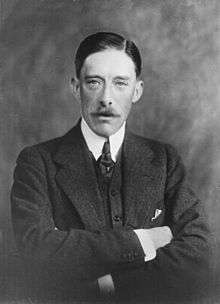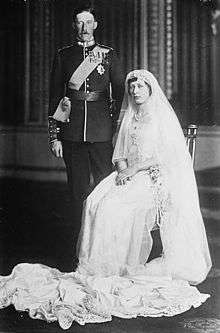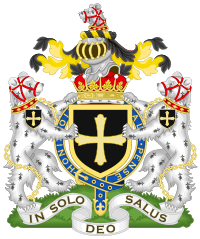Henry Lascelles, 6th Earl of Harewood
| The Earl of Harewood | |
|---|---|
 | |
| Tenure | 6 October 1929 – 24 May 1947 |
| Born |
9 September 1882 London, England |
| Died |
24 May 1947 (aged 64) Harewood House, Yorkshire |
| Buried |
27 May 1947 All Saints Church, Harewood, Yorkshire |
| Spouse(s) | |
| Issue | |
| Father | Henry Lascelles, 5th Earl of Harewood |
| Mother | Lady Florence Bridgeman |
Henry George Charles Lascelles, 6th Earl of Harewood KG GCVO DSO TD JP DL (9 September 1882 – 24 May 1947), styled The Honourable Henry Lascelles before 1892 and Viscount Lascelles between 1892 and 1929, was a British soldier, peer and a Yorkshire landowner. He was the husband of Mary, Princess Royal, and through her the son-in-law of King George V and Queen Mary and a brother-in-law to Edward VIII and George VI.
Family
Lascelles was the son of Henry Lascelles, 5th Earl of Harewood and Lady Florence Bridgeman, daughter of Orlando Bridgeman, 3rd Earl of Bradford. He was born at the London home of his maternal grandfather, 43 Belgrave Square.[1]

Lord Harewood married Princess Mary, only daughter of King George V of the United Kingdom and Queen Mary, at Westminster Abbey, on 28 February 1922. His best man was Sir Victor Mackenzie, 3rd Baronet.[2] It was later reported that Lascelles proposed to her after a wager at his club.[3]
After their marriage, Lord and Lady Harewood split their time between their homes; Chesterfield House (destroyed after the Second World War) in London, Goldsborough Hall, at Harwood Estate and Harewood House itself, in Yorkshire, which became their family home in 1929. They had two children:
- George Henry Hubert Lascelles, 7th Earl of Harewood (born at Chesterfield House 7 February 1923 – died 11 July 2011) and christened at St Mary's Church Goldsborough 25 March 1923
- The Hon. Gerald David Lascelles (born at Goldsborough Hall 21 August 1924 – died 27 February 1998)
Her elder son, the Earl of Harewood, wrote about his parents' marriage in his memoirs The Tongs and the Bones and says that "they got on well together and had a lot of friends and interests in common".
Military career
After education at Eton College, Lascelles attended the Royal Military College, Sandhurst[1] before being commissioned as a Second Lieutenant into the Grenadier Guards on 12 February 1902,[4] serving until 1905.[5] He was an honorary attache at the British Embassy in Paris from 1905 until 1907, then served as aide-de-camp to the Governor General of Canada, Earl Grey, until 1911.[1]
In 1913 he joined the Territorial Army as Second Lieutenant in the Yorkshire Hussars Yeomanry. He was promoted Lieutenant on the Reserve of Officers in 1914.[5] He continued with the yeomanry after the outbreak of the First World War until he rejoined the Grenadier Guards for service on the Western Front in April 1915.[1] Even so he continued to be promoted within the regiment to Captain in 1917.[6] Postwar he was promoted Major in 1920 and retired in 1924.[7]
Meanwhile, at the front, he was wounded in the head at the Second Battle of Givenchy but recovered to fight in the Battle of Loos in 1915, and was wounded a further two times as well as gassed.[1] He was promoted Captain and later Major in command of a battalion (the 3rd) in 1915,[5] and Lieutenant-Colonel in 1918.[6] He was awarded the Distinguished Service Order (D.S.O.) and a bar both in 1918, as well as the French Croix de Guerre.[7]
He continued his interest in the Territorial movement after the war, as Honorary Colonel of the 1st Battalion The London Regiment from 1923, the 5th Battalion West Yorkshire Regiment from 1937, and as President of the West Yorkshire Territorial Forces Association from 1928. He was also appointed in 1937 Honorary Air Commodore of the 609 (West Riding) Bomber Squadron of the Auxiliary Air Force.[8]
Other interests
After the war, Lascelles remained interested in local Yorkshire issues and events, often contributing to the Leeds Board of Management. He was president of the Yorkshire Rural Community Council.[9][10] He was Lord Lieutenant of the West Riding of Yorkshire from 1927 until his death.[1]
He was President of the Royal Agricultural Society of England in 1929 when that year's Royal Show was held at Harrogate.[1]
Interested in equestrian sports, he served as Master of the Bramham Moor Hounds from 1921,[7], was a steward of the Jockey Club, and co-editor of Flat Racing (1940) for the London Library.[1]
Lord Harewood, a Freemason, served as Grand Master of the United Grand Lodge of England from 1942 to 1947.[11]
Political
As Viscount Lascelles, he attempted to enter the House of Commons when he stood at a by-election in 1913 as Unionist candidate for Keighley, held when its incumbent Liberal Member of Parliament, Sir Stanley Buckmaster was appointed Solicitor General. In the three-cornered fight that also included a Labour candidate, he came second to Buckmaster by 878 votes.
He did not seek election again and his defeat led to a later distaste for politics. He declared in later life "every war in which Britain had been involved had been due to the inefficiency of politicians, and they began what soldiers had to end".[1]
On succeeding to his father's Earldom he became a member of the House of Lords.
Death and legacy
Lord Harewood died of a heart attack on 24 May 1947 at the age of 64 at his home, Harewood House. Lady Harewood, the Princess Royal, survived him by almost eighteen years and died in 1965.
It is widely understood that Virginia Woolf based the character of Archduke Henry on him in her novel Orlando, a tribute to her lover Vita Sackville-West. Henry Lascelles was one of West's suitors.[12]
Titles, styles, honours and arms
Styles
- 1882–1892: The Honourable Henry G. C. Lascelles
- 1892–1929: Viscount Lascelles
- 1929–1947: The Right Honourable The Earl of Harewood
Honours
British:
- Distinguished Service Order (DSO), with Bar – 1918
- Knight of the Garter (KG) – 1922
- Knight Grand Cross of the Royal Victorian Order (GCVO) – 1934
- Territorial Decoration (TD)
- Knight of Grace of the Order of St John of Jerusalem[7]
Foreign:
Arms

Ancestry
| Ancestors of Henry Lascelles, 6th Earl of Harewood | |||||||||||||||||||||||||||||||||||||||||||||||||||||||||||||||||||||||||||||||||||||||||||||||||||||||||||||||||||||||||||||||||||||||||||||||||||||||||||||||||||||||||||||||||||||||||||||||||||||||||||||||||||||||||||||||||||||||||||||||||||||||||||||||||||||||||||||||||||||||||
|---|---|---|---|---|---|---|---|---|---|---|---|---|---|---|---|---|---|---|---|---|---|---|---|---|---|---|---|---|---|---|---|---|---|---|---|---|---|---|---|---|---|---|---|---|---|---|---|---|---|---|---|---|---|---|---|---|---|---|---|---|---|---|---|---|---|---|---|---|---|---|---|---|---|---|---|---|---|---|---|---|---|---|---|---|---|---|---|---|---|---|---|---|---|---|---|---|---|---|---|---|---|---|---|---|---|---|---|---|---|---|---|---|---|---|---|---|---|---|---|---|---|---|---|---|---|---|---|---|---|---|---|---|---|---|---|---|---|---|---|---|---|---|---|---|---|---|---|---|---|---|---|---|---|---|---|---|---|---|---|---|---|---|---|---|---|---|---|---|---|---|---|---|---|---|---|---|---|---|---|---|---|---|---|---|---|---|---|---|---|---|---|---|---|---|---|---|---|---|---|---|---|---|---|---|---|---|---|---|---|---|---|---|---|---|---|---|---|---|---|---|---|---|---|---|---|---|---|---|---|---|---|---|---|---|---|---|---|---|---|---|---|---|---|---|---|---|---|---|---|---|---|---|---|---|---|---|---|---|---|---|---|---|---|---|---|---|---|---|---|---|---|---|---|---|---|---|---|---|---|---|---|
| |||||||||||||||||||||||||||||||||||||||||||||||||||||||||||||||||||||||||||||||||||||||||||||||||||||||||||||||||||||||||||||||||||||||||||||||||||||||||||||||||||||||||||||||||||||||||||||||||||||||||||||||||||||||||||||||||||||||||||||||||||||||||||||||||||||||||||||||||||||||||
References
- 1 2 3 4 5 6 7 8 9 Oxford Dictionary of National Biography, Volume 32. Oxford University Press. 2004. p. 592. ISBN 0-19-861382-2. Article by H.E. Wortham, revised by K.D. Reynolds.
- ↑ "'The Wedding of 6th Earl of Harewood and Princess Mary'". National Portrait Gallery, London. Retrieved 25 September 2015.
- ↑ Bradshaw, Peter (30 August 2017). "Sorry, Ivanka Trump: you make a pretty poor Princess Royal". The Guardian. Retrieved 30 May 2018.
- ↑ "No. 27405". The London Gazette. 11 February 1902. p. 846.
- 1 2 3 Kelly's Handbook to the Titled, Landed and Official Classes, 1918. Kelly's. p. 928.
- 1 2 Kelly's Handbook, 1920. Kelly's. p. 976.
- 1 2 3 4 Kelly's Handbook, 1929. Kelly's. p. 814. Entry under Viscount Lascelles (published before succession to earldom same year).
- ↑ Kelly's Handbook, 1945. Kelly's. p. 895.
- ↑ "Lord Harewood". Yorkshire Post and Leeds Intelligencer. West Yorkshire, England. 13 March 1943. Retrieved 25 September 2015.
... Lord Harewood, speaking on the report of the Board of Management, said was impressed the Increase last .. (Also, 28 March 1929...BOARD OF MANAGEMENT. Mr. Middleton re-elected ...(as) treasurer, and the following governors were appointed to form the Board Management in connection ...)
- ↑ "Lord Harewood's Letter". Yorkshire Post and Leeds Intelligencer. West Yorkshire, England. 12 April 1937. Retrieved 25 September 2015.
Lord Harewood's Letter Lord Bolton then read a letter from Lord Harewood. president of the Yorkshire Rural Community Council...
- ↑ "A Library and Museum of Freemasonry Information Leaflet: The Use of Standards and Banners in Freemasonry" (PDF). The Library and Museum of Freemasonry. November 2011. Retrieved 16 May 2018.
- ↑ "Orlando". sparknotes.com. Retrieved 25 September 2015.
- ↑ Burke's Peerage, Baronetage and Knightage, 1949. Burke's Peerage Ltd. p. 948.
- ↑ Burke's Peerage, Baronetage and Knightage, 1910. Burke's Peerage Ltd. p. 12.
- ↑ Image of the quartered arms of the 6th Earl of Harewood, Find a Grave. Retrieved 15 April 2018
External links
- Hansard 1803–2005: contributions in Parliament by the Earl of Harewood
- harewood.org
- goldsboroughhall.com
| Honorary titles | ||
|---|---|---|
| Preceded by The Earl of Harewood |
Lord Lieutenant of the West Riding of Yorkshire 1927–1947 |
Succeeded by The Earl of Scarbrough |
| Academic offices | ||
| Preceded by Robert Crewe-Milnes |
Chancellor of the University of Sheffield 1944–1947 |
Succeeded by E. F. L. Wood, 1st Earl of Halifax |
| Masonic offices | ||
| Preceded by The Duke of Kent |
Grand Master of the United Grand Lodge of England 1942–1947 |
Succeeded by The Duke of Devonshire |
| Peerage of the United Kingdom | ||
| Preceded by Henry Lascelles |
Earl of Harewood 1929–1947 |
Succeeded by George Lascelles |